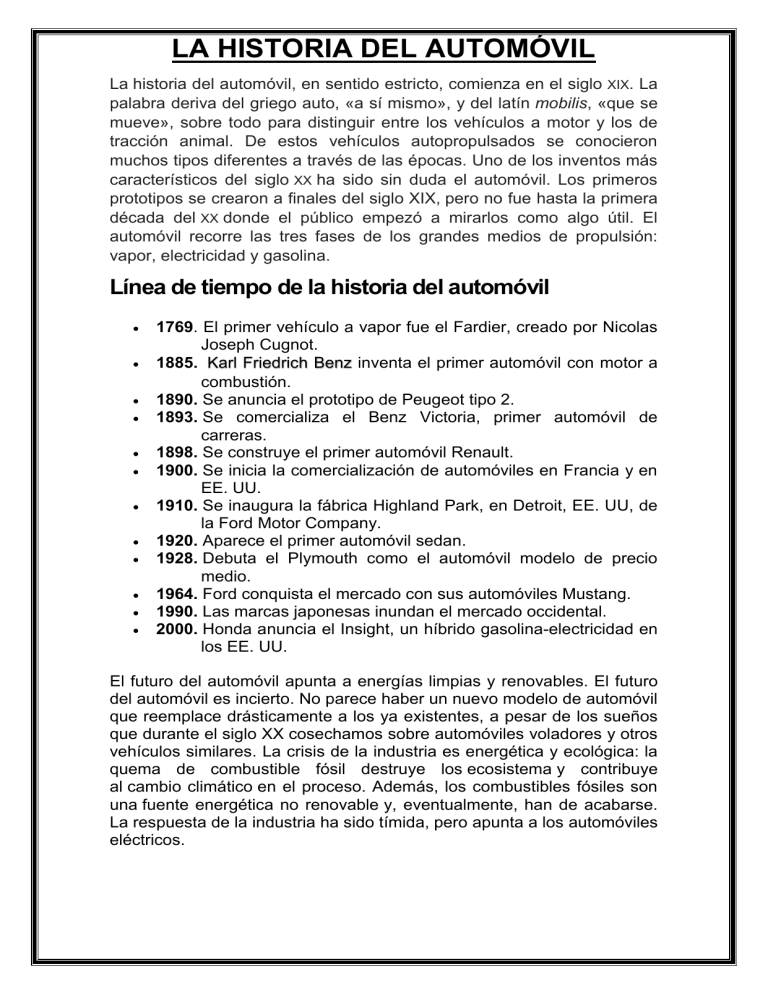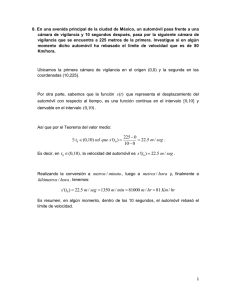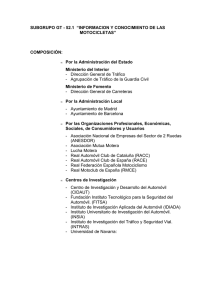
LA HISTORIA DEL AUTOMÓVIL La historia del automóvil, en sentido estricto, comienza en el siglo XIX. La palabra deriva del griego auto, «a sí mismo», y del latín mobilis, «que se mueve», sobre todo para distinguir entre los vehículos a motor y los de tracción animal. De estos vehículos autopropulsados se conocieron muchos tipos diferentes a través de las épocas. Uno de los inventos más característicos del siglo XX ha sido sin duda el automóvil. Los primeros prototipos se crearon a finales del siglo XIX, pero no fue hasta la primera década del XX donde el público empezó a mirarlos como algo útil. El automóvil recorre las tres fases de los grandes medios de propulsión: vapor, electricidad y gasolina. Línea de tiempo de la historia del automóvil 1769. El primer vehículo a vapor fue el Fardier, creado por Nicolas Joseph Cugnot. 1885. Karl Friedrich Benz inventa el primer automóvil con motor a combustión. 1890. Se anuncia el prototipo de Peugeot tipo 2. 1893. Se comercializa el Benz Victoria, primer automóvil de carreras. 1898. Se construye el primer automóvil Renault. 1900. Se inicia la comercialización de automóviles en Francia y en EE. UU. 1910. Se inaugura la fábrica Highland Park, en Detroit, EE. UU, de la Ford Motor Company. 1920. Aparece el primer automóvil sedan. 1928. Debuta el Plymouth como el automóvil modelo de precio medio. 1964. Ford conquista el mercado con sus automóviles Mustang. 1990. Las marcas japonesas inundan el mercado occidental. 2000. Honda anuncia el Insight, un híbrido gasolina-electricidad en los EE. UU. El futuro del automóvil apunta a energías limpias y renovables. El futuro del automóvil es incierto. No parece haber un nuevo modelo de automóvil que reemplace drásticamente a los ya existentes, a pesar de los sueños que durante el siglo XX cosechamos sobre automóviles voladores y otros vehículos similares. La crisis de la industria es energética y ecológica: la quema de combustible fósil destruye los ecosistema y contribuye al cambio climático en el proceso. Además, los combustibles fósiles son una fuente energética no renovable y, eventualmente, han de acabarse. La respuesta de la industria ha sido tímida, pero apunta a los automóviles eléctricos. THE HISTORY OF THE AUTOMOBILE The history of the automobile, strictly speaking, begins in the nineteenth century. The word derives from the Greek auto, 'himself', and from the Latin mobilis, 'which moves', especially to distinguish between motor vehicles and animal-drawn vehicles. Of these self-propelled vehicles many different types were known throughout the ages. One of the most characteristic inventions of the twentieth century has undoubtedly been the automobile. The first prototypes were created in the late nineteenth century, but it was not until the first decade of the twentieth where the public began to look at them as something useful. The car goes through the three phases of the great means of propulsion: steam, electricity and gasoline. Timeline of the history of the automobile 1769. The first steam vehicle was the Fardier, created by Nicolas Joseph Cugnot. 1885. Karl Friedrich Benz invents the first automobile with a combustion engine. 1890. Peugeot type 2 prototype is announced. 1893. The Benz Victoria, the first race car, is marketed. 1898. The first Renault automobile is built. 1900. The commercialization of automobiles begins in France and the U.S. 1910. The Highland Park factory, in Detroit, USA, of the Ford Motor Company is inaugurated. 1920. The first sedan automobile appears. 1928. Debuts the Plymouth as the mid-price model car. 1964. Ford conquers the market with its Mustang cars. 1990.Japanese brands flood the Western market. 2000. Honda announces the Insight, a gasoline-electric hybrid in the U.S. The future of the automobile points to clean and renewable energies. The future of the automobile is uncertain. There does not seem to be a new model of car that drastically replaces the existing ones, despite the dreams we had during the twentieth century about flying cars and other similar vehicles. The crisis in the industry is energetic and ecological: the burning of fossil fuels destroys the ecosystem and contributes to climate change in the process. In addition, fossil fuels are a non-renewable energy source and, eventually, they must end. The industry's response has been timid, but it points to electric cars.









